Journey to a cold and curious moonby Dwayne A. Day |
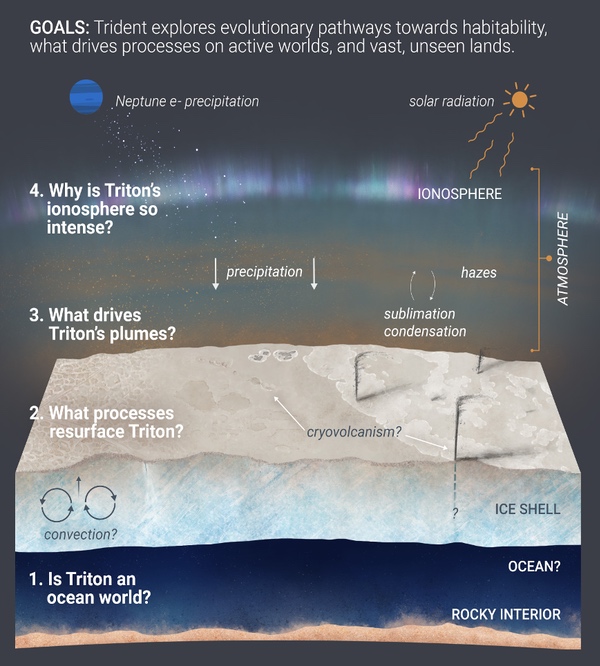 There are two theoretical explanations for Triton's geysers. One theory is that sunlight penetrates clear ice and heats material underneath, resulting in a cryovolcanic explosion. The other is that Triton could have an ocean under the ice and warm water breaks through as geysers. Triton also has an intense ionosphere that puzzles scientists. (credit: Trident team) |
Chaos moon
On September 23, 1846, Neptune was discovered by Johann Galle, and its large moon Triton was spotted a little more than two weeks later by English astronomer William Lassell. Lassell determined that Triton was orbiting in a direction opposite of Neptune’s rotation, the only large moon in the solar system that does this. Since this discovery, scientists have speculated that Triton is a captured object that originated in the Kuiper Belt, a circumstellar disc in the outer solar system extending from the orbit of Neptune at 30 astronomical units (AU) out to approximately 50 AU. An AU is the distance from the Sun to the Earth, making the Kuiper Belt very far out. Pluto is a Kuiper Belt Object, and Triton almost certainly is as well.
| The mission illustrates the science still to be done at the cold edges of our solar system and provides a blueprint for how missions to the edge of the solar system could be conducted on a budget. |
Triton’s capture by Neptune would have substantially heated Triton. Triton is also in a high-inclination orbit compared to Neptune’s equatorial plane, which some scientists have predicted is sufficient to maintain an internal ocean under the moon’s icy surface. But nobody was expecting this in 1989.
When Voyager 2 flew past Triton 143 years after its discovery, it revealed very few craters, indicating that Triton’s surface is relatively young: perhaps 50 million years old, or possibly even less than 10 million years old. This foreshadowed New Horizons’ 2015 encounter with Pluto, which also revealed a surprisingly young surface for a cold world in the outer solar system. Voyager revealed that Triton is dynamic, with various processes resurfacing it, including volcanism, tectonic movement, and sublimation. Voyager also wowed scientists by revealing Triton’s surface to be very diverse, with several different types of terrain, most notably the “cantaloupe” terrain that covers much of its surface—named that because it looks like the skin of a cantaloupe.
The crazy plumes that Voyager found are located on the volatile-rich south polar terrain. The generally accepted theory is that they result from the explosive venting of dark material from beneath transparent ice, but there is no agreement about the exact cause. An early theory was that this was a “solid-state” process whereby sunlight passed through the ice and heated material below it, turning it to gas, building up pressure until it burst through the surface ice. But a more recent theory is that Triton may harbor a subsurface ocean like that on Saturn’s moon Enceladus, which may drive icy volcanic eruptions in the same way. If true, that could have major implications for the search for life in the universe.
These various characteristics mean that Triton is a member of three distinct populations: Kuiper Belt Objects like Pluto, ocean worlds like Ganymede, Titan, Europa and Enceladus, and plume worlds like Europa and Enceladus. Triton could provide useful information for understanding all three populations. There’s also another aspect of Triton that makes it so interesting and odd: it has a surprisingly active ionosphere. For a moon that we would normally expect to be frozen and uninteresting, Triton defies expectations. Scientists want to know why, and several years ago some of them proposed a mission known as Trident to explore it.
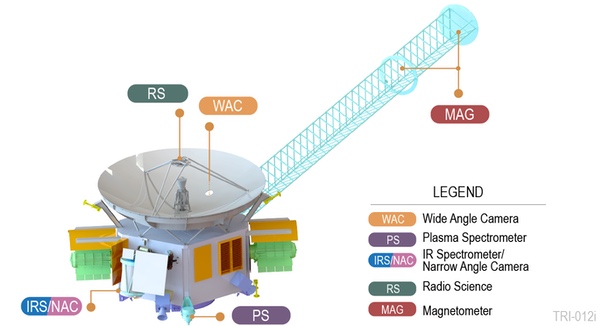 The Trident team proposed a standard suite of instruments for the spacecraft. Unlike the instruments used on the New Horizons mission, these would not have to operate at low power during the flyby. Instead, the spacecraft would carry batteries that would be charged by RTGs. This approach would have kept the instrument cost lower than New Horizons. (credit: Trident team) |
Tiny spacecraft, big journey
“The Trident concept actually came out of a two-day Architecture Team study in 2017, coincidentally not long before the Cassini Grand Finale,” explained Karl Mitchell, of the Jet Propulsion Laboratory and a Project Scientist on the Trident proposal team. “A team of scientists and engineers were brought together at the request of Brent Sherwood and Kim Reh, who were in charge of the JPL Discovery Program portfolio, and asked the question, ‘What new mission concepts would be enabled if the next Discovery call included the option for RTGs?’”
RTGs, or radioisotope thermoelectric generators, are essentially “atomic batteries” powered by plutonium-238, an isotope of the rare element that is not used to make bombs but instead conveniently gives off a substantial amount of heat that can be converted directly into electricity. RTGs can provide power when sunlight is too dim for solar panels, or where mission operations make solar panels hard to use. The Perseverance and Curiosity rovers use a Multi-Mission Radioisotope Thermoelectric Generator (MMRTG). Cassini used RTGs at Saturn and New Horizons needed one to operate near Pluto.
| Prockter said that the mission wasn’t originally named “Trident,” “but we were worried about the copyright implications of calling it ‘Project Hoth.’” |
JPL looked into what they might do with RTGs on smaller missions. “These sorts of brainstorming sessions are often run at JPL,” Mitchell explained, “and I’m fortunate enough to be one of those that they regularly call on. They’re typically a lot of fun, involving fast-paced creative design. Naturally most of the concepts involved either distant or shadowed parts of the solar system where sunlight was weak. Several of us that were present, including myself, suggested a Triton flyby mission. It was a particularly popular suggestion, as due to its distance from Earth, many consider Triton to have been neglected, despite Voyager 2 showing what a fascinating world it is.”
Mitchell decided to follow up on that work with Bill Smythe, who has a lot of experience in balancing science and engineering in mission design. Smythe was also one of the A-Team study participants. “Separately, Nitin Arora, a trajectory/mission designer, came up with an enabling trajectory, so we at least knew it was viable,” Mitchell added. They started expanding the team and defining the science goals. They then presented the concept to an internal review team at JPL and received a green light to continue. They added more people, notably Candy Hansen who was involved in the Voyager 2 flyby and had led a previous Neptune-Triton mission study. When they decided that they needed a principal investigator to lead the entire effort, Mitchell went to Louise Prockter.
Prockter was then the director of the Lunar and Planetary Institute located near NASA’s Johnson Space Center in Texas. LPI was established in the late 1960s to conduct scientific studies of the Apollo samples. Prockter is a planetary geologist and veteran of several previous space missions, most recently the MESSENGER spacecraft, which orbited Mercury from 2011 to 2015. She is also involved in the Europa Clipper mission.
She remembered being asked if she would be interested in working on the Trident proposal. “I immediately said yes,” she recalled, “as Triton is such a fascinating moon, and the concept was bold and exciting. Soon afterwards they asked me if I would consider being the PI and I jumped at the opportunity.” She also added that the mission wasn’t originally named “Trident,” “but we were worried about the copyright implications of calling it ‘Project Hoth.’”
Prockter explained that she considers Triton to be a fascinating planetary target. “Triton appears to be an unusual end-member icy world, but we have only had tantalizing glimpses of its surface. Voyager showed weird and dynamic geological processes, an extremely young and active surface including plume eruptions, atmospheric clouds and hazes, and a strangely intense ionosphere.”
She added that in the 30 years since the Voyager flyby, ground-based telescopic observations have added a bit more to our understanding of the moon. “The atmosphere is dynamic and there may be changes on the surface due to exchange of materials between the surface and atmosphere. Modeling of Triton’s capture and orbital evolution interior suggests that Triton likely contains an ocean today, kept liquid because of a different tidal forcing process than that found at other icy satellites such as Europa and Ganymede,” she explained. “If Triton has an ocean, it will change our understanding of what conditions are needed to make a potentially habitable world.” In addition, only 40% of the surface has been imaged at resolutions sufficient to determine geological features, “so there is a whole hemisphere waiting to be discovered.”
Candy Hansen considered herself as “the Voyager veteran” on the Trident team. “I was involved in the original Voyager Neptune flyby, working as the Experiment Representative at JPL for the Imaging Science Team,” she recalled. The Imaging Science Team was strewn across the country, at the US Geological Survey in Flagstaff, Arizona, and a variety of universities.
“In those almost pre-Internet days I was responsible for representing their interests on a daily basis for everything from camera observation design and command generation to processing the images for press releases and publications,” she remembered. “At that point in time I was working on my PhD, and ultimately used Voyager images of Triton for my dissertation. I modeled the seasonal processes on Triton, and what the fans on the surface—presumably from past plumes—told us about atmospheric wind conditions.”
It might seem weird now, but before Voyager, the solar system was a simpler place—because we knew very little about it, and made limited assumptions based on limited data, such as the assumption that small, cold, planetary bodies would be old and frozen. “I worked with the Voyager imaging team from launch through all the flybys,” Hansen said. “The sheer diversity in our solar system was a lesson we learned over and over again.” Many papers and dissertations and books resulted from the two Voyager missions, and many scientists had their favorite planets or rings or moons that fascinated them after the Voyagers revealed some of their mysteries.
Triton was Hansen’s muse: “Triton has its own unique geology that I am fascinated by, we don't really know how ices are distributed across its surface. I really want to see that being especially intrigued by seasons! What is driving those plumes? How do the colors correlate to the compositions of surface materials? What is the atmospheric pressure, and on and on.” Hansen, now a senior scientist at the Planetary Science Institute, thinks that Trident can provide those answers. “Voyager gave us one snapshot in time. Trident will give us another snapshot decades later and I am fascinated by imagining what changes we might see.”
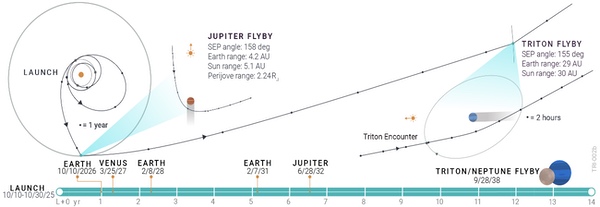 The proposed Trident mission to Neptune’s moon Triton would have used a clever “ballistic trajectory” that requires minimal fuel for course corrections. (credit: Trident team) |
Getting there
The team’s goal was to produce science data from a Triton flyby within a “reasonable timeframe.” The spacecraft would launch in 2025, arriving at Triton in 2038. It would fly a unique trajectory first identified by Nitin Arora. Trident would go past Venus—using its high gain antenna as a thermal shield—and fly past Earth twice, then head past Jupiter in 2032, bending its orbit to head towards Neptune. The team called this a “ballistic trajectory” because it requires almost no additional propellant after firing out of Earth’s gravity. The spacecraft would weigh 1,095 kilograms plus 134 kilograms of hydrazine. For comparison, Voyager 2 came in at 825 kilograms, and New Horizons was 478 kilograms Trident would be considerably heavier because of a decision to carry many batteries onboard, charged by the RTGs.
| If the mission had been approved and launched in 2025, by 2038 Trident would pass within 500 kilometers of Triton, inside the moon’s thin atmosphere. By comparison, New Horizons flew past Pluto at a distance of 12,500 kilometers. |
One of the inherent characteristics of missions to the far outer planets is that great distances mean long travel times. So, the Trident team made sure to invite co-investigators across a range of career levels, with the aim of ensuring that the more senior members with more mission experience can mentor and train the more junior co-investigators. This was to ensure that they had all the expertise needed throughout development, cruise, and the encounter at Triton in 2038. Prockter noted that her deputy, Carly Howett, was much younger and had a different skillset and would take over if Prockter was unable to continue as PI.
The spacecraft would go into hibernation during much of the long cruise, and the science team would primarily work on other projects during that time, but continue to prepare and see what additional science could be gleaned about Triton from Voyager data, ground-based observations, and modeling. They would also want to carry out in-flight calibration of the instruments as the spacecraft flew by other bodies such as Jupiter, Io, Venus, and by looking at stars, to ensure everything was working well.
The proposed Trident instruments would have included a magnetometer for enabling detection of a subsurface ocean. It would also carry an infrared spectral and narrow-angle camera. Trident would carry a wide-angle eclipse imager, and a plasma analyzer and spectrometer. Finally, it would include gravity and atmospheric occultation radio science.
If the mission had been approved and launched in 2025, by 2038 Trident would pass within 500 kilometers of Triton, inside the moon’s thin atmosphere. By comparison, New Horizons flew past Pluto at a distance of 12,500 kilometers. This close pass would allow Trident to closely image the surface, sample its ionosphere with a plasma spectrometer, and get so close that it could conduct highly detailed magnetic induction measurements that could verify the existence of a subsurface ocean. It would also pass through a total eclipse making possible atmospheric occultations of both Triton and Neptune.
The proposed spacecraft would have included high-capacity onboard memory storage, enabling near-full-body mapping over the course of one Triton orbit. After swinging past Triton, Trident would also have been able to image the moon with light reflected off Neptune’s blue atmosphere—Neptuneshine.
Getting to Triton in 2038 would have enabled Trident to capitalize on a narrow observational window, allowing scientists to assess changes in Triton’s plume activity and surface characteristics since Voyager 2 last imaged it in 1989. Arriving later means the Sun will be farther north on Triton: some of the plumes will be in twilight and the far southern portion will no longer be visible. Prockter explained that “the main thing about the timing of Trident is that we want to catch the Sun before the subsolar point moves northward off the southern nitrogen-ice cap, so we can test the sublimation model,” which theorizes that the plumes are caused by sunlight passing through the nitrogen ice and heating up material underneath. “There may be new plumes near the equator which will be in broad daylight, but not originating from the nitrogen cap, so that would mean they are probably cryovolcanic and not the result of sublimation.”
The two competing theories about where the plumes come from on Triton can potentially have a major scientific impact depending upon which one is correct. If the plumes are caused by the “solid-state” process of heating material under the ice, that would be unique, but not necessarily exciting. But if Triton really does have a subsurface ocean, and if the geysers are an indication of hydrocarbons circulating in and out of that ocean, then that means that Triton now fits the definition of a habitable world. That would blow wide open the possibilities for habitable worlds in the universe.
Our current definition of habitable worlds requires that they be in the Goldilocks zone, near enough to a star that water can exist in liquid form, or like Europa, near a big planet that can cause tidal heating. Triton is also near a big planet that can cause tidal heating, but Triton is also a captured Kuiper Belt Object, and that means that it migrated in from the cold dark void, got captured, warmed up, and could now possibly be warm enough to support life. Maybe Triton is not only active ionospherically and geologically, but in other ways as well. Maybe there are critters swimming around in a vast ocean under Triton’s ice. Maybe the same thing has happened on other worlds throughout our galaxy, far from warming suns. Maybe Trident can help find that out.
Often proposed missions seek to accomplish their science objectives in new ways and must convince proposal reviewers that they can be successful. Magnetometry is an accepted method for detecting an ocean under ice, but so far it has required multiple orbits or flybys of a planetary body. Trident proposed detecting Triton’s ocean using magnetometry from a single flyby, which Prockter described as “a new and bold idea.” She always knew that would be a tough sell. “There are some in the community who do not believe it can be done, or who believe that Triton’s ionosphere will obscure any signal from the ocean. We have done extensive modeling to show that we can detect any subsurface ocean that has a reasonable depth and salinity, but sometimes these ideas need a few years in the literature to gestate and for people to do their own associated modeling to verify that something can be done,” she explained.
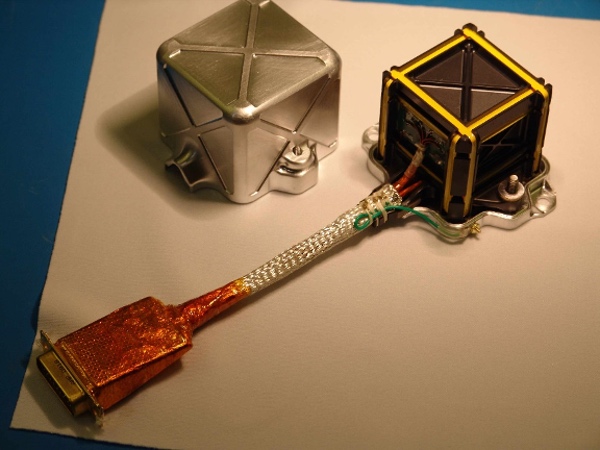 Magnetometers can be used to determine if icy worlds conceal vast oceans under their ice. The Trident team made a radical proposal to use this technique with a single flyby, while dealing with Triton’s intense ionosphere. (credit: Trident team) |
Outer planet exploration on a tight budget
In February 2019, Trident was selected by NASA along with three other Discovery mission proposals for further study with the plan of selecting two missions for development in early 2021. Discovery missions had a cost cap of $500 million, not including the launch vehicle, mission operations, or science analysis. If Trident was selected, the team would have four years to build and launch the spacecraft to meet the 2025 launch date, although they could launch in 2026 if necessary. This was still a relatively aggressive timeline, and more recent problems encountered at JPL cast doubt on whether it could have been achieved without substantial effort.
| While the ballistic trajectory was probably the cleverest trick for the mission that affected its cost, there was another one relating to how Trident would manage its power. |
Building an outer planets mission for less than $500 million is an amazingly ambitious goal, because sending a spacecraft to the outer planets usually costs a lot more than that. Mitchell agreed that a major challenge to getting selected was convincing people they could do the entire mission on budget, “especially as we’re going further than any mission ever has been at that price point,” adding that New Horizons also got past 30 AU but had roughly double the budget.
The Trident team followed a careful engineering design philosophy and benefitted from some advantages not previously available to competitors. They also had some tricks up their sleeves. Mission designers picked instruments that have already flown before that did not have any extra features. Nothing was fancy. The instruments would all be fixed to the spacecraft body, requiring no gimbals or scanning platforms that cost money and increase risk.
The team also benefitted from some changes in the rules NASA applied to Discovery mission costs. Discovery operations and science costs—known as Phase E costs for space missions—were not included in the Discovery cap for the 2021 mission round. That meant that the 12 years of flying to Triton would not count against the program even though that would cost more than a shorter-lived mission. In addition, NASA was providing up to two RTGs—a current version known as an MMRTG—in the Discovery call for only $69 million, whereas the previous cost was $103 million for the same RTGs. Once that was deducted from the $500 million cost cap, that left Trident with $431 million to build the spacecraft.
Many of the things that enable the mission to stay within the Discovery cost cap are design choices that are intricately related. The “ballistic” trajectory requires little propulsion capability, so designers selected a lower cost, lower performance propulsion system with a small fuel tank. It uses hydrazine instead of a combination of fuels. The smaller mass of the fuel system in turn lowered the mass on the spacecraft, enabling a smaller, lower-cost rocket; as anybody who knows spacecraft is aware, mass costs money.
While the ballistic trajectory was probably the cleverest trick for the mission that affected its cost, there was another one relating to how Trident would manage its power. When New Horizons flew past Pluto, all the spacecraft instruments ran off the very low power from the single radioisotope thermoelectric generator. This required that New Horizons’ instruments be designed for low power operations, which proved expensive. Mission designers for Trident chose a simpler, brute force approach: they would equip the spacecraft with a bunch of inexpensive batteries that would be slowly charged by the two MMRTGs. During the Triton flyby, all the instruments would run off batteries, and they would not have to be specially designed for very low power operations, thereby controlling costs. They would be heavy, but the ingenious trajectory made that less relevant than for other missions.
The science campaign for the flyby would have lasted ten days and start when the narrow angle camera and the infrared spectrometer turned on. The rest of the instruments would turn on just before the flyby, and the batteries would be drained of power during the science campaign, with a little bit being added back in by the MMRTGs.
Schedule
In June 2021, NASA selected two Venus missions for the Discovery program, VERITAS and DAVINCI+. Trident and a proposed mission to Jupiter’s moon Io were not selected. Unfortunately, due to the position of Neptune and its orbit, the Trident mission could not miss its 2025/2026 launch window and still achieve its science goals. If a future mission to Triton is proposed, it will have a different timeline and significantly different science goals.
In recent years NASA’s planetary science program has experienced substantial budget and schedule pressure. The opportunities for future competed science missions are unclear. In spring 2022, the planetary science decadal survey was released and one of its top priorities is a flagship-class mission to Uranus. Uranus and Neptune are ice giants of equal scientific interest, although their accompanying moon systems are different. (See “All the myriad worlds,” The Space Review, May 16, 2022.) It may be a long time before NASA sends a robotic mission to Neptune and its mysterious intriguing moon. But the Trident proposal demonstrates that there are clever people working on ideas about how to get there.
Note: we are using a new commenting system, which may require you to create a new account.
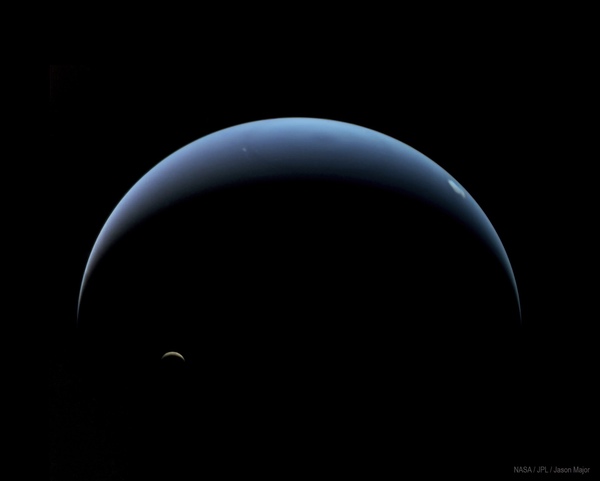
No comments:
Post a Comment